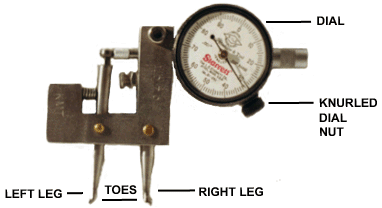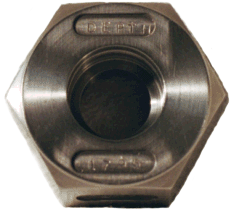
Procedure to standardize the Kile Diameter Gauge used for aerosol can crimp diameter measurements.
1. Standardize the Diameter Gauge before using in the following manner. This is required at reasonable intervals as determined by the degree of accuracy that is needed.
2. Take the Hexagonal Standard Gauge Block as shown. Make sure the Standard Block has an identification number stenciled on the side of the block in the machined-out recess. (If not, contact the gauge supplier).

3. Turn the Standard Gauge Block so the side marked "Dia." is face up (note the dimension for the diameter in the machined-out recess).
4. Place the Diameter Gauge in the right hand with the dial to the right.
5. Insert the left leg of the Diameter Gauge into the Standard Gauge Block groove, lightly pushing the Diameter Gauge to the left until the right leg engages in the Standard Gauge Block.
6. After engagement, slowly counter rotate the Diameter Gauge in the Standard Gauge Block until they work smoothly together. Align the Diameter Gauge in the Standard Gauge Block so it is perpendicular to the top of the Standard Gauge Block and at a position where the true diameter of the Standard Gauge Block opening is displayed which is the highest number that can be obtained. The Diameter Gauge should then show the last two (2) numbers of the dimension stamped on the Standard Gauge Block. To get the true reading, add 1.0" to the dial reading. (See note below)
7. If the Dial does not read the last tow-nimbers stamped into the Standard Gauge Block, loosen knurled nut at the side of the face of the dial and move the dial face so needle lines up with the poper reading. Re-lock the knurled nut.
Once the Depth Gauge has been properly stadardized, can crimp depths may then be determined.
1. Before using the Diameter Gauge, mark the valve cup at the center of each crimping segment indentation of the crimping collet.
2. Hold the Diameter Gauge in the right hand with the dial face up. Hold the can to be checked in the left hand.
3. Insert the left leg of the Diameter Gauge into the crimped valve cup, moving the Diameter Gauge to the left until the right leg of the Diameter Gauge engages the valve cup crimped area.
4. With the can to be checked in the left hand, Diameter Gauge in the right hand, slowly counter rotate the can and Diameter Gauge until a smooth feel is developed between opposite collet segment indentation.
5. With Diameter Gauge perpendicular to the can curl, record the highest number shown on the dial near the center of each opposing collet segment indentation. This number can be corrected to the actual measure ment by placing 1.0 in front of the dial reading. (Example: If dial reading is 72 the true diameter reading is 1.072").
6. Counter rotate the can and Diameter Gauge to a new set of opposing segments indentation and determine the dial reading as in #5 above. Do this operation until you have read the diameter of all opposing collet segment indentations.
The user assumes all risk of use or handling, including all risk of consequential or incidental damages, whether or not use or handling is in accordance with directions.
Note: Some Standard Gauge Blocks are stamped to the nearest five ten thousandths of an inch. For these use the last three numbers.